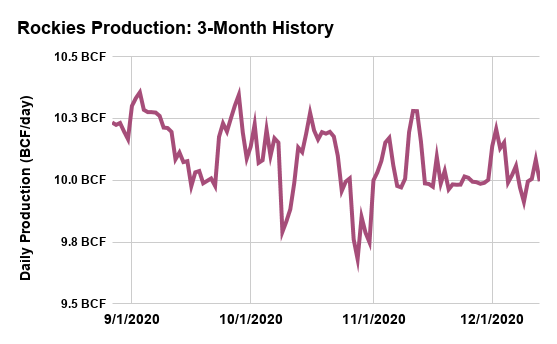Home --> Natural Gas Main -->Natural Gas Supply/Demand Data --> Natural Gas Production
Modeled daily domestic natural gas production data based on pipeline flows. Early-cycle data for the upcoming day is updated at approximately 12 AM EDT each morning. This is then revised the following evening based on late-cycle data.
|
|
Late Cycle Production Revision
Early-cycle pipeline data for the next day becomes available by around 9 PM EDT. However, this data is often an estimation of expected supply or is incomplete, resulting in significant revisions--using upward--when final data comes out late the next evening or the following morning. The figure below plots early-to-late cycle revisions for the past 7 days.
|
Daily Natural Gas Production: 5-Year Historical Comparison
|
| Natural Gas Regional Production |
Natural Gas Production Regions
1) South Central Region: Encompasses the EIA's former "Producing" Storage Region (1993-2015) and is the largest of the four regions. It encompasses the Gulf Coast and adjacent states and includes the San Juan, Permian, Eagle Ford, Anadarko, Haynesville, Woodford and Fayetteville formations, among others. A large fraction of natural gas output in this region is the consequence of associated gas production due to widespread oil drilling.
2) Appalachia: The newest and, until recently, the fastest growing region. It primarily encompasses Ohio, West Virginia, Pennsylvania, and New York and includes the Utica and Marcellus shale formations.
3) Gulf Of Mexico: Formally produced upwards of 8 BCF/day or 15% of US gas production at its peak in 2006, but with the rise of onshore shale production over the past decade, output has dwindled to around 2 BCF/day or less than 3% of US output. It includes the continental shelf and some deep water wells from Texas to Louisiana.
4) Rockies: The smallest of the three onshore producing regions and includes Utah, Colorado, Colorado, Wyoming and Montana.It encompasses the Niobara and western Bakken shales formations.
Note: Regional production statistics do not include output from California or Alaska, which do not fit into any of these regions, but make up less than 3% of US supply.
|
 |












